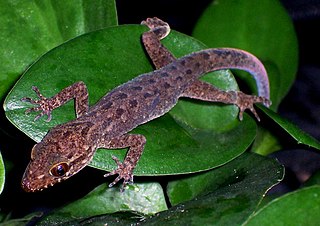
Gekkonidae is the largest family of geckos, containing over 950 described species in 62 genera. The Gekkonidae contain many of the most widespread gecko species, including house geckos (Hemidactylus), the tokay gecko (Gekko), day geckos (Phelsuma), the mourning gecko (Lepidodactylus), and dtellas (Gehyra). Gekkonid geckos occur globally and are particularly diverse in tropical areas. Many species of these geckos exhibit an adhering ability to surfaces through Van der Waals forces utilizing intermolecular forces between molecules of their setae and molecules of the surface they are on.

Gonatodes is a genus of New World dwarf geckos of the family Sphaerodactylidae.

Cyrtodactylus is a diverse genus of Asian geckos, commonly known as bent-toed geckos, bow-fingered geckos, and forest geckos. The genus has 354 described species as of 2023, which makes it the largest of all gecko genera.

Union Island is part of the nation of Saint Vincent and the Grenadines. It has a surface of 9 square kilometres (3.5 sq mi) and lies about 200 km west-southwest of Barbados within view of the islands of Carriacou and the mainland of Grenada, which lies directly south.

Gekko kuhli, commonly known as Kuhl's flying gecko, Kuhl's parachute gecko, or the gliding gecko, is a species of lizard in the family Gekkonidae. The species is found in Southeast Asia.

The harlequin gecko, formerly Hoplodactylus rakiurae, is a species of gecko, a lizard in the family Diplodactylidae. The species is endemic to Stewart Island/Rakiura in the far south of New Zealand, where it was discovered in 1969. In terms of distribution it is one of the southernmost gecko species in the world.

The British Virgin Islands dwarf sphaero, Virgin Gorda least gecko, or Virgin Islands dwarf gecko is a species of gecko and also one of the smallest terrestrial vertebrates. It has only been found on three of the British Virgin Islands: Virgin Gorda, Tortola, and Moskito Island. It was discovered in 1964 and is suspected to be a close relative of Sphaerodactylus nicholsi, a dwarf sphaero from the nearby island of Puerto Rico. It shares its range with the big-scaled least gecko (S. macrolepis), which is found in leaf litter. Unlike this larger gecko, the Virgin Islands dwarf sphaero lives on drier hillsides, yet prefers moist microhabitats found under rocks because it lacks the adaptations necessary for preventing water loss, which is a significant problem due to its small body size.

Gymnophthalmus underwoodi, called commonly Underwood's spectacled tegu, is a species of microteiid lizard, which is found in South America and on certain Caribbean islands.
Sphaerodactylus kirbyi, commonly known as the Bequia dwarf gecko, the Bequia sphaero, or the Grenadines sphaero, is a species of gecko, a lizard in the family Sphaerodactylidae. The species is endemic to Bequia, an island in the Grenadines that is part of Saint Vincent and the Grenadines.

Gonatodes albogularis, which has been called a number of vernacular names in English, is a smallish species of gecko found in warm parts of Central and South America, Cuba, Hispaniola and Jamaica. They prefer to live in tropical dry forest habitats. It is sexually dimorphic: the male is colourful, while the female is a more drab grey. The fingers do not have lamellar pads for climbing smooth surfaces like many other geckos but instead have normal claws like most lizards. At one time the species had a breeding population in southern Florida, especially Key West, but this population appears to have died out by the early 1990s. They are believed to be able to tell the difference between brightness and hues of conspecifics. Males are incredibly aggressive with territory defense against both other males and potential predators.
Robert ″Bob″ Powell is an American herpetologist. His main research interest is in the herpetofauna of the Caribbean.

Haseman's gecko is a species of lizard in the family Sphaerodactylidae. The species is indigenous to northern South America.
Gonatodes nascimentoi is a species of lizard in the family Sphaerodactylidae. The species is endemic to Brazil.
Peters' gecko is a species of lizard in the family Sphaerodactylidae. The species is endemic to Venezuela.
The Estado Aragua gecko, also known commonly as the ring-necked clawed gecko, is a species of lizard in the family Sphaerodactylidae. The species is endemic to Venezuela.
Jacques Pierre Marie Daudin was a Chinese-born French agronomist and environmentalist, who lived and worked in the Caribbean and west Africa. Much of his later life was spent on Union Island, in Saint Vincent and the Grenadines. The Union Island gecko, scientifically described in 2005, is endemic to the island and named in his honor. He was the author of the books Socio-Political History of Union Island and A Natural History Monograph of Union Island.











